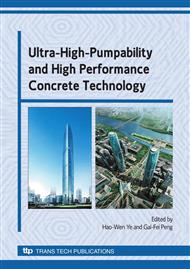p.267
p.272
p.278
p.283
p.289
p.296
p.303
p.309
p.315
Investigation of the Ability of Alkali Binding by C-S-H and C-A-S-H Gels
Abstract:
The binding of sodium and potassium into cement paste influences the performance of concrete: for example, alkali balances between solid and paste constituents and pore fluid affect the potential for alkali aggregates reaction. However, quantification of the binding potential into paste solids has proven to be difficult, although much empirical data are available from pore fluid analyses. In this study, single-phase homogeneous C-S-H phases have been prepared at Ca: Si molar ratios (C/S) of 1.8, 1.6, 1.3, 1.0 and 0.8 and reacted with four alkali hydroxide concentrations, both NaOH and KOH, between 10 and 300 mM. A steady-state alkali partition is attained in less than 4d at 20°C by flame emission spectroscopy and the ξ potential of C-S-H and C-A-S-H gel unreacted and reacted with alkali hydroxide are measured. The results indicate:alkali binding into the C-S-H and C-A-S-H gel improves as its C/S decreases;Al3+ has been introduced to form C-A-S-H gels, and the influence of Al3+ on alkali sorption properties was determined: the replacement of Si4+ by Al3+ and Na+ or k+ markedly increases alkali binding and decreases the ξ potential of gel;the more Ca:Si ratio,the less alkali binding, the more ξ potential of gel.
Info:
Periodical:
Pages:
289-295
Citation:
Online since:
January 2009
Authors:
Keywords:
Price:
Сopyright:
© 2009 Trans Tech Publications Ltd. All Rights Reserved
Share:
Citation:


